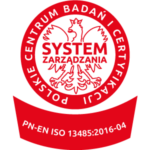PARAGLOVE
The work included the design and manufacture of a functional prototype of a glove to propel handbike for tetraplegics.
This type of bicycle is hand-powered, which allows it to be used also by people with disabilities resulting from spinal injuries and people with lower limbs paresis.
Handbike is a popular sport among disabled people and is also a Paralympic discipline. Competitions are organised all over the world, differing in length and profile of routes, and also take part in marathons.
Our gloves are aimed for people with hands paresis who cannot hold the propelling crank by themselves. The solutions we have used in the glove allow the wearer to put on and adjust the glove themselves, ensuring a repeatable hand position. This aspect is particularly important for athletes participating in competitions, so that the hand is positioned as it was during training and does not change its position, minimising energy loss.
The mount on the glove is compatible with the standard handbike mountings for tetraplegics, using a pin to quickly disconnect the glove from the crank, allowing to correct the chain while riding, or a cheer at the finish line.
The work included the design and manufacture of a functional prototype of a glove to propel handbike for tetraplegics.
This type of bicycle is hand-powered, which allows it to be used also by people with disabilities resulting from spinal injuries and people with lower limbs paresis.
Handbike is a popular sport among disabled people and is also a Paralympic discipline. Competitions are organised all over the world, differing in length and profile of routes, and also take part in marathons.
Our gloves are aimed for people with hands paresis who cannot hold the propelling crank by themselves. The solutions we have used in the glove allow the wearer to put on and adjust the glove themselves, ensuring a repeatable hand position. This aspect is particularly important for athletes participating in competitions, so that the hand is positioned as it was during training and does not change its position, minimising energy loss.
The mount on the glove is compatible with the standard handbike mountings for tetraplegics, using a pin to quickly disconnect the glove from the crank, allowing to correct the chain while riding, or a cheer at the finish line.






The design process of the glove began with a meeting with Rafał Mikołajczyk – the Polish Champion and a titled para-cycler. Rafał told us what bothers him about the glove he has used so far and what requirements he has for the new one. During the meeting we performed a 3D scan of his forearm and hand to adjust our design to his anatomy.
Based on the interview, we created the first concepts of the solution, its appearance, strategic points of attachment and adjustment of the glove. Once Rafał accepted our solutions, we went on to design the first prototype.
The outer part of the glove was made of carbon fibre laminate to provide stiffness, while the inner part was printed based on the user’s hand scan and upholstered with perforated neoprene for comfort of use and ventilation.
The design process of the glove began with a meeting with Rafał Mikołajczyk – the Polish Champion and a titled para-cycler. Rafał told us what bothers him about the glove he has used so far and what requirements he has for the new one. During the meeting we performed a 3D scan of his forearm and hand to adjust our design to his anatomy.
Based on the interview, we created the first concepts of the solution, its appearance, strategic points of attachment and adjustment of the glove. Once Rafał accepted our solutions, we went on to design the first prototype.
The outer part of the glove was made of carbon fibre laminate to provide stiffness, while the inner part was printed based on the user’s hand scan and upholstered with perforated neoprene for comfort of use and ventilation.








The first prototypes were made using the 3D printing method, they allowed Rafał to try on the glove and check if the shape fits the hand and keeps it in the right position, whether there are any difficulties with putting on and taking off the glove, fastening it and attaching it to the bike mount.
Based on the feedback received, further prototypes were created, and when the intended result was finally fully achieved, it was time to produce a functional carbon fibre prototype. The project was properly adapted for production from carbon laminates, and on its basis short series moulds were created, which enabled us to produce functional prototypes at relatively low cost.
The new gloves met Rafał’s growing expectations and allowed him to compete at the highest level and achieve further success.
The first prototypes were made using the 3D printing method, they allowed Rafał to try on the glove and check if the shape fits the hand and keeps it in the right position, whether there are any difficulties with putting on and taking off the glove, fastening it and attaching it to the bike mount.
Based on the feedback received, further prototypes were created, and when the intended result was finally fully achieved, it was time to produce a functional carbon fibre prototype. The project was properly adapted for production from carbon laminates, and on its basis short series moulds were created, which enabled us to produce functional prototypes at relatively low cost.
The new gloves met Rafał’s growing expectations and allowed him to compete at the highest level and achieve further success.









